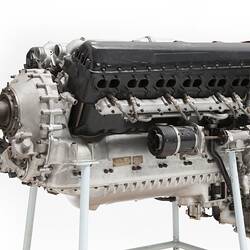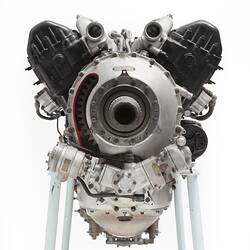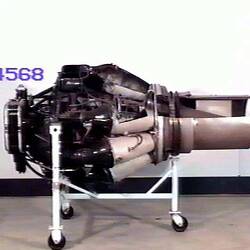Summary
The Merlin is one of the best known and most significant liquid-cooled piston aero engines ever produced. It evolved from the Rolls-Royce PV12 of 1933 which was a development the Rolls-Royce Kestrel. Early versions of the Merlin powered the Hurricane and Spitfire fighter aircraft flown by the Royal Air Force (RAF) during the Battle of Britain. It was developed continuously throughout World War II at factories including Derby and Crewe in the United Kingdom and was built in the United States of America by Packard. It powered numerous British service aircraft types including most versions of the Avro Lancaster bomber and also enabled the US-designed P-51 Mustang to fulfill its potential as a long-range escort fighter over Germany. The Merlin was used in aircraft flown and serviced by Royal Australian Air Force (RAAF) personnel in Europe, Africa and the Mediterranean as part of RAF Bomber, Fighter, Training and Coastal Commands. It was also used in Australia to power Fairy Battle trainers and Supermarine Spitfires. Later, locally-made and imported RAAF Mosquito and Mustangs used Packard Merlins. The Commonwealth Aircraft Corporation assembled the Merlin 102 using some imported parts under licence for the post-war GAF Lincoln bomber built in Australia. The Merlin was also modified for use in tanks such as the Meteor.
This imported Mark 46 Merlin 1,100 hp (820 kW) engine (serial no. 91315) was installed in Supermarine Spifire Mk Vc BS181 of 54 Squadron RAF on 3 July 1942 after manufacture at Derby and shipping to Australia. On 12 November 1942 this aircraft was delivered to No. 54 Squadron RAF. At this time the Squadron was working out of Richmond, New South Wales, in preparation for operational deployment in defence of the Darwin area as part of No. 1 Fighter Wing which also included Nos 452 & 457 Squadrons RAAF. The Wing deployed to the Darwin area in February 1943 with 54 Squadron based at Darwin airfield. BS181 was usually flown by Flight Lieutenant John Lenegan who had painted the name 'Yvonne' on the port engine cowling. On 6 February 1943, BS181 was being flown by Flight Lieutenant Bob Foster when he and wingman Flight Sergeant Mahoney intercepted a Japanese Army Ki-46 Dinah reconnaissance aircraft. The Dinah, which was operating with the 70th Dokuritsu Hiko Chutai, was shot down over the sea becoming the first Japanese aircraft brought down by the No.1 Fighter Wing over Northern Australia and the first enemy aircraft shot down by a Spitfire pilot over Australia.
On 10 June 1943 BS181was being flown by Flying Officer John Lenegan when he made a forced landing at Millingimbi after experiencing engine failure with a connecting rod through the crankcase. The Merlin was removed and sent to No.7 Repair & Salvage Unit (RSU) for repair following which it was allocated to 452 Squadron RAAF. The engine was installed in Spitfire Mk Vc A58-97 (BS236) on 13 October 1943. Following overhaul in January 1944 (A58-97 had been noted as having "poor performance"), this aircraft was issued to 457 Squadron in March 1944.
By this time the Spitfire Mk Vc had been withdrawn from front line operations with the RAAF and replaced with the Mk VIII. In October 1944 Merlin 91315 was installed in Spitfire Mk Vc A58-253 serving with 2 Operational Training Unit (OTU) at Mildura, Victoria. The aircraft was then taken on charge with 8 OTU at Parkes, New South Wales, completing a ferry flight to Parkes from Mildura on 28 October 1944. The engine was removed in January 1945 and overhauled by No.1 Air Depot (AD) at Laverton before returning to Parkes and being fitted to Spitfire Mk Vc A58-47 in April 1945 - A58-47 was being repaired following a wheels-up landing at Parkes on 29 March 1945. The engine was removed from this aircraft in early September 1945 and returned to store at 1 AD in unserviceable condition with excess oil blowing back through the breather. It was apparently not repaired and was issued to the Museum in 1946 with 365.55 total running hours recorded.
The engine was sectioned by an external constractor for the Air Transport display in McArthur Hall that opened in March 1970 as part of the Museum's centenary celebrations,
More Information
-
Collecting Areas
-
Acquisition Information
Donation from Royal Australian Air Force (RAAF), 1946
-
Manufacturer
-
User
Royal Australian Air Force (RAAF), Melbourne, Greater Melbourne, Victoria, Australia, pre 1946
-
Brand Names
-
Classification
Air transport, Aero engines, Reciprocating propeller engines
-
Category
-
Discipline
-
Type of item
-
Overall Dimensions
1915 mm (Length), 780 mm (Width), 1400 mm (Height), 630 kg (Weight)
Overall dimensions of Aero Engine and Display Stand. Height to centreline of propellor shaft: 1050 mm. Approximate weight estimate for engine and strand, based on information in Air Ministry Maintenance Manual for Merlin 45, 46, 47, 50 & 56 Engines, published August 1942 (see TL 40131), which quotes Engine Weight, nett dry (i.e. without coolant or lubricants) as 1,385 lbs. Note this engine is sectioned so weight would be a little less t
-
Part Dimensions
1915 mm (Length), 780 mm (Width), 1115 mm (Height), 625 kg (Weight)
Dimensions of Aero Engine only, excluding display stand.
-
Other Dimensions
1168 mm (Length), 762 mm (Width), 829 mm (Height)
Dimensions of Display Stand only. Footprint of feet: 30 inch x 46 inch; Height of stand: 32? inch to top of mounting plates; Area of top mounting: 38 inch x 20½ inch.
-
References
Fred Woodgate, "The Lions And The Swans", A History of 54 Squadron.
[Archived Resource] 1942. Aero Engine Log Book.
-
Keywords
Aero Engines, Fighters, Internal Combustion Engines, Military Aircraft Components, Wars & Conflicts, World War II, 1939-1945











